|
Markets are Random ... or are they? |
Once upon a time I ran across a discussion, in
Morningstar, of
Randomness in the Stock Market. I got to thinking ...
>Good for you!
... that, although the future evolution of the market (or a particular stock)
isn't predictable with any degree of accuracy, one doesn't expect every future is
equally likely. Some futures are more likely than others.
>Like the weather, eh? Snow in July? Unlikely.
Exactly! Yet a weather prediction which is off by a few degrees is quite likely.
>In Dallas, it's likely to be off by 10 degrees. I remember, one summer ...
Anyway, I suspect it's reasonable to consider that markets have a certain degree of uncertainty which may be large ... or small. Just like the weather. A forecast which gives tomorrow's time of sunrise, say 5:24 AM, has little uncertainty. A forecast which says that tomorrow's DOW will increase by 200 points has a much larger uncertainty. Suppose we consider a stock which grows, monthly at a fixed, deterministic rate of 1.2% plus a random, hence unpredictable, rate. Is the future evolution random?
|
>Not entirely, I'd say ... it does have a random component.
The chart at the right shows two possible 15-year evolutions. Although we can't be sure of the
random component, we'd like to feel that there's a more predictable component involved.
Well, the first is, but the second is .... uh ... the last fifteen years of the S&P 500.
|
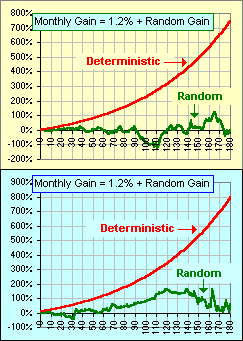
|
>Are you saying that the S&P 500 has a predictable component?
I'm saying that there's a degree of uncertainty associated with the S&P 500, but the past
fifteen years can be generated as a combination of a deterministic component
plus a random component. However ...
>What about the next 15 years?
Good question. However, I can promise you that, whatever it is, it can be generated
as a combination of a deterministic component plus a random component.
>And can you tell me what the deterministic component is, for the next fifteen years?
No, but ...
>Then you might as well consider it entirely unpredictable!
No, I don't think so. It just has a certain degree of uncertainty. By deterministic, I
mean that we can determine this component, from historical precedent. It's like
predicting the weather next week. We look at historical weather patterns and make a
determination. Then we guesstimate the random component, trying to reduce the degree of uncertainty
associated with this component by looking at weather patterns elsewhere, prevailing winds, jet stream activity,
price/earnings ratios, if the Feds meet that week, quarterly earnings reports, etc..
>So you're saying that you can evaluate the deterministic
component, for the next fifteen years.
Well, I have a better chance of estimating the random component in the short term.
Fifteen years is a long time and the best we can do is look at historical precedent
and use that to extrapolate. That'd give us a deterministic component. The random component
depends upon so many things that we cannot know. Besides, even
my deterministic component may not agree with yours, but I suspect we'll both make a
determination which involves a higher market value fifteen years from now.
>Based upon historical precedent?
Yes. That's the significance of the word deterministic, from the philisophical idea of
determinism, that man's
actions are determined by antecedent causes ...
>And women's actions?
I hold to the view that the principles which govern our behaviour, and, indeed, the behaviour of the physical world, are partly deterministic, partly random. Newton's Laws of Motion, for example, have a small random/unpredictable component. They've served us in good stead for hundreds of years, yet we cannot guarantee that they define the future evolution of the universe. Indeed, Einstein generated a different set of Laws. Each can be used as a deterministic component to predict the future ... and each has an associated unpredictable component. Each is based upon the observed, antecedent - or prior - behaviour of the world, and each is used to predict future events with, hopefully, a small random error.
Have you ever heard of
Heisenberg's Uncertainty Principle?
>No, but ...
It doesn't matter. In any case it should not
deter us from trying to estimate the deterministic component. For example, if we knew the past
history of a comet, Sir Isaac Newton would have said that the entire future path of the
comet is deterministic. Heisenberg would disagree. There's always uncertainty.
>Mumbo jumbo.
A completely deterministic philosophy would say that man has no free will. All actions
have been programmed. All future events are pre-determined, by certain incontrovertible
Laws. However, if we accept the idea that the future is at least partly random
and is governed by Laws which are only partly deterministic, then we can choose to act
this way or that ...
>You wax philisophical.
Why do we think the sun will rise at, say, 5:24 AM?
>Because we know that, historically, the time of sunrise has been predictable.
But that doesn't guarantee that the prediction for tomorrow will be accurate. It just says
that it's been that way for eons, so we expect it to be that way tomorrow.
The degree of uncertainty is small. How do we know that? Because prior predictions have been
accurate.
It's like the markets.
For years it's been growing, over the long term, so we have some confidence in saying it'll
grow in the future ...
>Long term.
Yes, long term. Of course, that's no guarantee that ...
>But for the predicted rise of the sun, tomorrow or next month,
we have equations, physics, an in-depth knowledge of astronomical ...
Of course, but even the equations are based upon examining the past behaviour ... and they've
been accurate in the past, with a small error, so ...
>Heisenberg, right? We can't know precisely, with zero error.
Right, yet ...
>I say that the DOW will change, tomorrow, by ... uh, somewhere between zero and 800 points.
Very little uncertainty there, because ...
>Because it's never had a bigger change - in the past.
Right, but that's no guarantee that ...
>I say that the Nasdaq will increase by 50 points, tomorrow.
That's enough.
The point is that the markets have a random component, but they're not
entirely random. As for stocks, some are more random than others. Some have a greater
degree of uncertainty than others. Some ...
 |
>I suppose you're going to tell me that Standard Deviation measures that uncertainty. Hmmm ... you're much smarter than I thought. Anyway, the molecules of gas in a container
execute random motions ... yet there's a predictable pressure on the walls of the container.
Even in what appears to be randomness, there can be order and predictability. I toss a coin
a thousand times. If it comes up Heads, I add 1. If Tails, I add 0. The
average number, over a thousand tosses, is predictable.
|
There's always uncertainty, but the degree of uncertainty is small, like tomorrow's sunrise.
>But you can't identify randomness from a graph, can you? I mean,
have you ever seen the pressure waveform for Beethoven's Fifth Symphony... on an oscilloscope?
It looks pretty random, but ...
|
Okay, here's a stock ... a real stock: But the 1980s were turbulent times. There was a crash in '87, remember?
Okay, let's see what the degree of uncertainty is.
Uh ... yes ... was. | 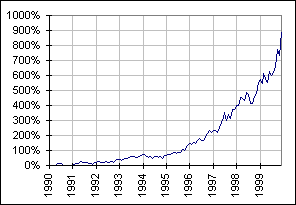
|
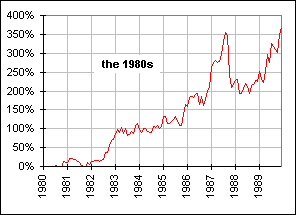 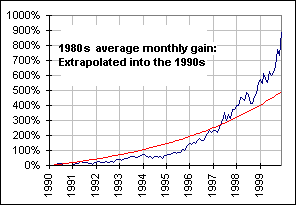
|
Here's the 1980s. First thing we'll do is try to eliminate some of the noise.
>Noise? Pay attention. We'll smooth out the graph by taking the average monthly gain (which happens
to be 1.503%, for this stock) and using that monthly gain to extrapolate into the 1990s. That'd
give the second chart.
There is a large degree of uncertainty, but I did get a graph that's increasing, sometimes
larger than the actual 1990s graph, sometimes smaller, sometimes ...
... and the average error is just under 5%.
Yes, yes, but remember I said there's uncertainty ... and it could be large or small. |
>You said it's a real stock ...
It was General Electric.
>It is General Electric. Anyway, I thought we were talking
about the market, not one stock.
Okay, here's the same scheme for "the market".
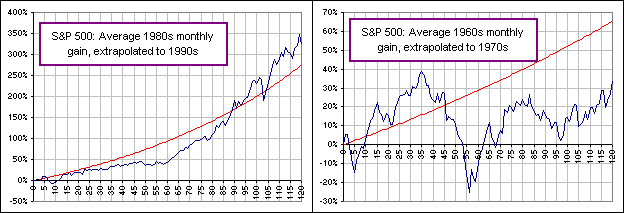
>Hmmm ... even the degree of uncertainty is ... uh ...
Uncertain. Yeah. But if you do a Monte Carlo simulation, using historical
data (like the Mean Return and Standard Deviation), you get jillions of "possible" evolutions
of a market or portfolio and ...
>How does the simulation compare to a deterministic evolution ...?
Good question. Here's a picture of a spreadsheet. In the upper right corner are several
simulations (in blue) and a deterministic graph
(in red).
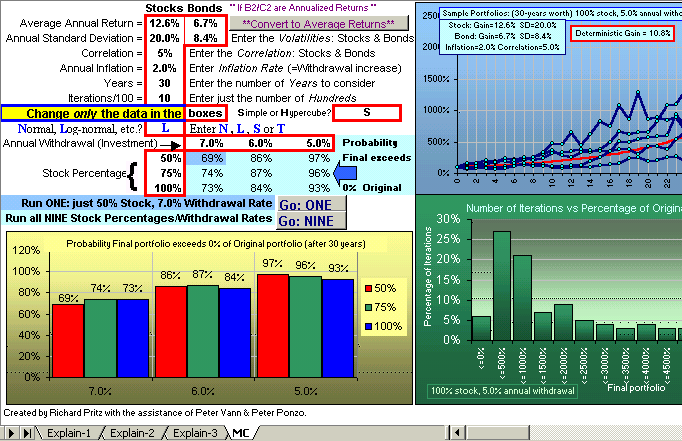
The deterministic graph uses a fixed annual return (based upon precedent) whereas the Monte Carlo simulations use a random selection of returns (selected from a log-Normal distribution), but ...
>Looks like the simulations sorta fluctuate about the deterministic.
You stole the words ...
>... right out of your mouth. Can I play with the spreadsheet?
Sure. Just Right-Click on the picture, above, then Save the file (not the picture!) to download a .ZIPd copy. Note: it has macros.
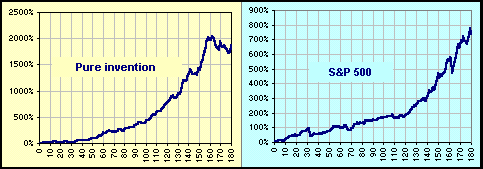

 for Part II
for Part II